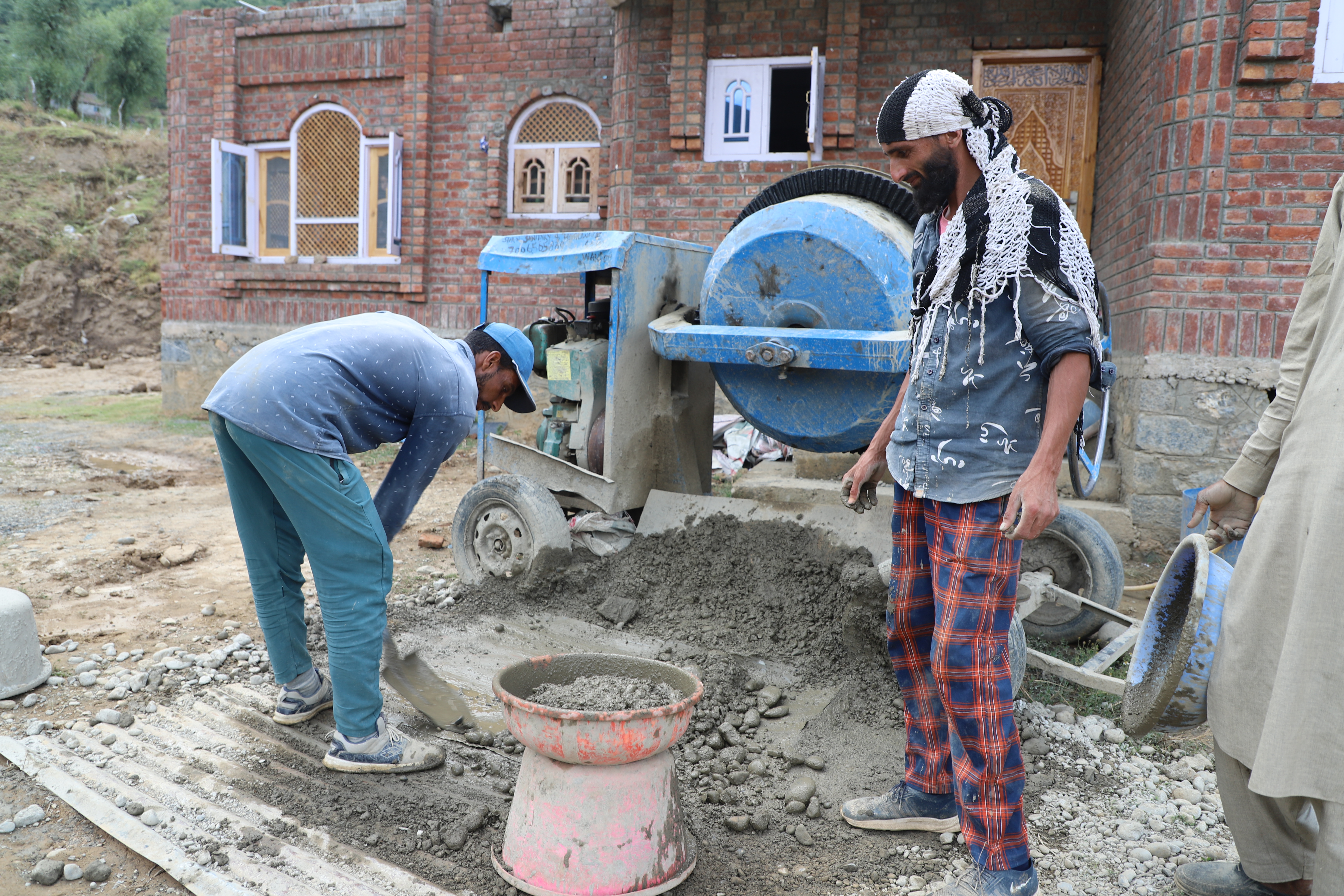Lower Munda: On a steep mountain slope covered behind with dense forest of towering Deodar and Kail trees, a modest concrete two-room house marks the last human footprint.
From the porch, one can gaze at a sprawling view below, zigzagging roads, tiny tin roofs and distant mountain peaks shimmering under the afternoon sun.
For decades, Abdul Rasheed Kasana, a 74-year-old pastoralist from the Bakerwal community roamed these ridges with his flock of sheep and goats, searching for grazing pastures. But now, he is forced to retire, spending his days in a small hamlet at Lower Munda, far from the highlands he once called home.
Practice of biannual migration

The Gujjar-Bakerwal and Gadi communities of Jammu and Kashmir, the largest transhumant populations in the region, have long practiced biannual migration. Every year, nearly 700,000 people walk hundreds of kilometers, herding their livestock between alpine pastures in Kashmir and Ladakh starting April-May and reverse migration plains in Jammu in September-October
This biannual migration is vital for their livelihood and shields their livestock from extreme weather conditions. But the primitive migration is under threat by erratic weather events including cloudbursts, flash floods and rising temperatures.
Over the last five years, rising temperatures in Jammu have forced nomads to begin their migration earlier in March or April. But icy conditions in the mountains often result in starvation and death among their livestock, causing devastating losses. These challenges have also disrupted the education of their children who rely on mobile schools during the migration.

Natural changes affect life
While they have adopted a new routine to stay in lowland areas around mountains in the Kashmir Valley till snow melts in mountains in May but the alpines and meadows too have become unbearable for them in summers due to rising heat followed by cloudbursts and unseasonal rains. These natural changes have forced many to abandon pastoralism and adapt to labour or construction work to sustain their families.
But many like Kasana struggle to adapt to a new trade. In 2023, he recalls a tragic night when lightning and flash floods struck during his migration from Jammu to Kashmir along National Highway 44.
“We had stopped to rest under some trees after a tiring day of walking in intermittent rain,” Kasana says. “In the middle of the night, a loud thud from the skies woke us. It felt like the apocalypse. Within seconds, we were drenched and 20 of my sheep were missing.”
By morning, Kasana found the carcasses of 12 sheep buried under a mound of soil and mud. It changed our lives and fortune,” he rues.

According to the 2011 census, Gujjars and Bakerwals make up nearly 1.1 million of Jammu and Kashmir’s 12.54 million population. However, increasing instances of extreme weather like heat, flash floods and cloudbursts are destroying their livestock and stripping them of their key source of livelihood.
Between 2010 and 2022, Jammu and Kashmir recorded 168 extreme weather events, mostly cloudbursts and flash floods, according to official estimates. In 2023 alone, South Asia Network on Dams, Rivers and People documented 12 cloudbursts, eight of which occurred during June and July. In fact, a major cloudburst at the Hindu pilgrimage site, Amarnath cave nestled at an elevation of 3,800 feet in snow-covered mountains of Kashmir’s picturesque Pahalgam killed 16 pilgrims in 2022.

Weather extremes
While some of the incidents are documented, experts and officials admit, many of them go unrecorded due to their occurrence in remote reaches with lack of access or connectivity.
“Cloudbursts are directly linked to rising temperatures,” explains Director of the Meteorological Centre (MeT) in Srinagar Dr Mukhtar. “As heat increases, so does moisture and low-pressure systems in the air, leading to sudden downpours.”
Over the last few years, Jammu and Kashmir has experienced 0.5 degrees rise in average temperatures, with July 2023 recording the hottest day in over seven decades at over 36 degrees. It was the second warmest July since 1946, as per the MeT records.
Independent weather forecaster, Faizan Arif added that prolonged dry spells followed by heavy rains are triggering frequent cloudbursts. “This is a major concern for marginalized communities and those living in high-altitude areas,” he warned.
Grazing stress
These climate changes spelled doom to grazing and depleted water resources, spurring early return from highland pastures at several places this year.
A veterinary doctor, who was part of the government’s team accompanying the pastoralists to highland pastures told ETV Bharat that they could observe ‘grazing stress’ triggered by the prolonged dry spell.

“Pastures are filled with high quality green grass. It has more nutritious and medicinal value compared to lowlands. With conducive temperature, it allows livestock to gain body weight,” he said. But this year, the veterinarian noted, livestock could not gain much weight because of limited availability of grass.
“The heatwave stunted growth of grass besides decreased the food intake capacity of animals, increasing the chances of spreading diseases,” he added.
For pastoralists, these extreme weather events coupled with the massive concretisation are devastating as it puts them at the verge of penury. “Each sheep is our child,” says 33-year-old Muzaffar Ahmad Kasana, who lost his left leg after a truck hit him on mountainous National Highway 44 during migration in 2015 and is sitting at home now. “Now, our livestock dies in the rain and heat. What’s the point of taking them to forests for grazing only to see them perish?”
In 2022, the Jammu and Kashmir government started a transport facility to ease migration for the community besides saving them from road accidents. Yet, tribal researcher Dr Javid Rahi argues that short-term measures are insufficient and calls for policy interventions, including livestock insurance, increased compensation for losses and better access to forest grazing lands.
“The pastoral community has been evicted from forests they inhabited for centuries,” Rahi said. “This alongside climate change and disease outbreaks has forced 40 percent of families to abandon biannual migration. Many now work as unskilled laborers or domestic helpers.”
Challenges and concerns
The Forest Rights Act (FRA) of 2006 extended to Jammu and Kashmir in 2020 initially gave hope to the community. The law grants tribals rights to forest resources and protection against eviction. But Rahi claims the FRA has instead displaced many families from their natural habitats.

“Our people who lived in forests for generations were evicted and grazing lands are now fenced off,” said Basharat Ali, a pastoralist with 500 livestock in the mountains of Mansar in Jammu. “Even we can’t collect water in some areas as razor wires restrict the movement. How will our livestock survive in such situation?”
The 55-year-old with two children who are government employees fears the nomadic practice rearing livestock might not last for more than a decade now in the face of these changes.
“Our people are uneducated and they know no other trade,” Ali added. “Now many are begging on roads or working as construction workers. They live in makeshift tents pitched on someone’s land or river banks at many places.”

Begging the only option?
On the outskirts of Srinagar and elsewhere, many displaced pastoralist families often rely on colleting alms or domestic work to survive. In Bemina, the largest residential colony housing service class, for example, several women from the community work as domestic helps in daytime.
“My husband suffered fracture in leg while we were migrating with our sheep and goat. He can barely walk since then,” said a woman begging for alms alongside her counterpart from Rajouri’s Kalakote. “We sold our livestock and there is no source of income now to support our kids.”
The government offers monetary compensation for livestock losses—Rs 3,000 per animal under the State Disaster Relief Fund. But for the community, the amount is too meagre to allow them to buy fresh livestock.
“I lost 20 sheep worth Rs 300,000 but I have spent over Rs 10,000 traveling to government offices without receiving anything,” added Kasana. One sheep, as per Kasana, was worth Rs 15,000.
Although the officials from the government’s Revenue department and doctors had examined and conducted post-mortem of the loss on ground as per the official documents, he laments not receiving a single penny.
“I have already lost too much. If they ever pay, they will only compensate two-thirds of my losses,” Kasana added.
Threat to Pastoralists
Director of the Sheep Husbandry Department Kashmir Dr Rafiq Ahmad Shah concedes the compensation under SDRF is far low to compensate the loss of a sheep or goat. He is worried about the weather changes occurring in the region saying it is threatening the centuries old practice of pastoralists.
Now, Dr Shah disclosed the department has shifted from cash to providing livestock as a replacement for the livestock lost. However, the scheme caps compensation at 30 animals and excludes losses below five.
“Most pastoralists now prefer to admit their children to schools and aim for government jobs,” said Dr Shah, who has himself served in highland pastures as part of the doctors team accompanying the community in summers. “Apart from weather events, road accidents and wild animal attacks are also covered in the scheme."

He cites education and economic alleviation for prompting many to quit living the primitive lifestyle and relying on Ajadi community, who are socially and economically downtrodden, for rearing their livestock.
“It is a tough job,” Dr Shah said. “A majority of pastoralists are admitting their children to schools and preferring government jobs. But now, the Ajadi community too is educating their kids. It will affect the migration as soon as their children grow.”
Read More:



